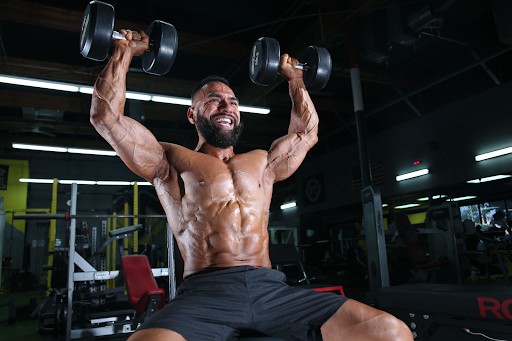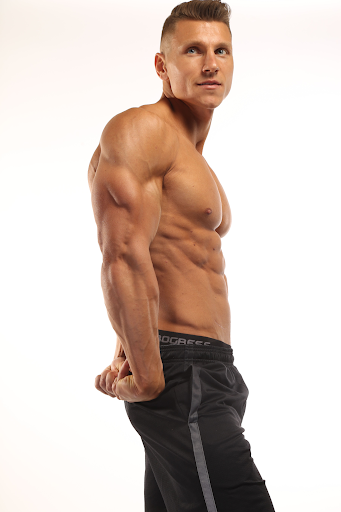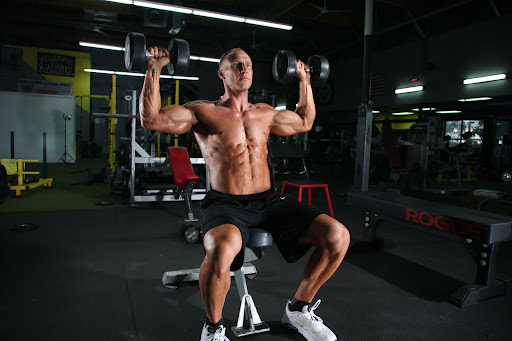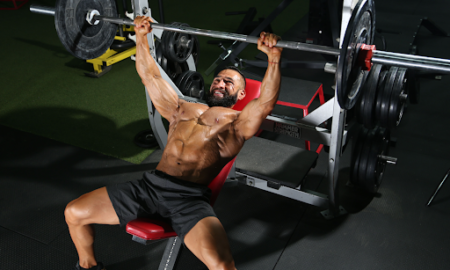

Boulder Shoulders: Why You Should Be Doing Dumbbell Shoulder Presses
Having great, fit shoulders has always been one of the most desired esthetic features. Broad shoulders are a symbol of strength and confidence. Therefore, the importance of dumbbell shoulder presses in creating a perfect physique is not trivial. First off, the overhead press relies upon a natural yet robust movement that results in positive muscle growth. Although the range of motion is straightforward, the benefits transcend muscle growth. Fitness experts recommend the dumbbell shoulder press exercise to correct posture defects in the upper back and promote joint integrity. As such, it doesn’t matter if you are sedentary because lifting weights over your head is one of the best ways to build muscle while also improving joint structures. Even though the concept is straightforward, a poorly executed shoulder dumbbell press can be devastating. Keep in mind that the shoulder joint is quite delicate and has a high risk of injury. For this reason, understanding the basics of the shoulder dumbbell press is the first step toward avoiding injury. This guide explains how you ought to execute the overhead press, its variations, as well as benefits.
How To Perform A Dumbbell Shoulder Press
Overhead pressing comprises two basic variations. The press can either be done in the standing or seated position, but each follows the same guidelines.
How to do a standing overhead press
- Stand upright with feet shoulder-width apart. Your face and neck should be neutral, and your back and abs activated to stabilize your spine and core.
- Grab two dumbbells with an overhand grip and create a stable base of support by adjusting the position of your feet as necessary. Tighten your core and back muscles for a neutral posture. Flex the elbows to shoulder level – this is your starting posture.
- From this point, initiate the upward movement by pressing the dumbbells toward the ceiling. Keep motion at the shoulder and wrist joints natural and as smooth as possible.
- At the top of the lifting phase, keep a slight flex at the elbows with palms facing in front. Pause for two seconds without clanging dumbbells at the top.
- Transition into a smooth descent by bending the elbows. However, don’t let the dumbbells go lower than the shoulders.
- Repeat this for a complete set.
How to do a sitting overhead press
- Sit on an inclined bench with steady back support. Grab a pair of dumbbells in each hand and evenly distribute your weight.
- Ground your feet firmly on the floor about shoulder-width apart. Engage your core and back and leave a slight gap between the chair and your lower back.
- Flex your elbows and push the dumbbells until they are ear level. Thus, this is the starting position.
- Push the dumbbells overhead until they nearly touch without clanging. Maintain a slight flex at the elbows and pause at this position.
- At the top, pause for a couple of seconds before slowly lowering the dumbbells to ear-level
- Repeat this movement to your desired number of reps.

Muscles worked
The shoulder joint is quite intricate. There’s a large bulk of muscle groups that a dumbbell shoulder press targets. These include:
- Deltoids (medial, anterior, and posterior sides)
- Triceps and minimally biceps
- Trapezoids
- Pectoralis major and minor
Anatomically, two muscle layers control shoulder motion; bulky superficial muscles and an inner group of smaller muscles that form the rotator cuff, including:
- Supraspinatus
- Infraspinatus
- Teres minor
- Subscapularis
Therefore, as you vary the routine and choose different adaptations of the dumbbell shoulder press, you can effectively engage and grow these muscles.
Tips
Shoulder dumbbell pressing is energy-sapping. Admittedly, the final set has intense muscle soreness, and slipping out of form is easier said than done.
Furthermore, poor form is the leading cause of shoulder and neck injuries. Sticking to the recommended form throughout goes a long way in injury prevention.
The overhead press is a safe exercise if you get the technique right. Therefore, to execute the movement and stimulate optimal muscle growth, there are some tweaks to implement:
- Carefully choose your weights. Do not be a show-off and start lifting at the business end of the scale. On the contrary, choose weights that allow you to finish a full workout without necessarily getting you worn out. As a rule of thumb, test the dumbbell weight with approximately 10%-15% of your body weight. After you have mastered that weight, you can grow your endurance and muscle memory and gradually progress to heavier dumbbells.
- Start with five minutes. All fitness routines should start with a pre-workout warmup. Warming up is ideal for activating muscles and joints. It also increases blood flow to your muscles. Warming up gets you ready to lift heavy loads and work comfortably in various motions, thus preventing injury.
- Stabilize the back. The key to maintaining your form is keeping your spine neutral and upright. This ensures that pressure transmits through deltoids, traps, upper chest, and rotator cuff muscles. Furthermore, this protects your shoulder and neck from injury.
- Decide the number of reps and sets. At the beginner level, you should comfortably hit 3 sets of 6 to 8 reps. Intermediate to advanced levels can go beyond this – 3 sets of 8 to 12 reps with a 2-minute recovery break.
Mistakes to avoid and solutions
- Flared elbows – It gets harder to maintain your form as you get tired. Once exhausted, your elbows may angle out farther than necessary. If you feel like you are getting tired and need a break, space out each set and recover. And if need be, use lighter dumbbells and adjust your grip.
- Avoid locking elbows at the top – Obliteration of the elbow flex occurs whenever the upward press is too rapid. Locked elbows will shift tension from the triceps and upper shoulders to the biceps. Ensure that while pushing upward, stop a few degrees shy of full extension at the elbow.
- Clanging dumbbells – To avoid clanging dumbbells while overhead, use slow motion in the upward press. Be sure that you are holding the dumbbells correctly.
- Lowering dumbbells too low – While executing the dumbbell shoulder press, do not let the dumbbells depress lower than shoulder level. This upsets the mechanics and increases the possibility of a shoulder injury. Instead, try moving a bit slower during the lowering phase to avoid going below shoulder level.
- Rounded back – Hunching your shoulders and upper back will possibly happen because of a poor posture or getting overburdened by the weight of the dumbbells. This posture can also result in threatening back and neck injuries. The solution – adequately engage your core and back muscles to maintain an upright and neutral spine.
Other shoulder exercises
Apart from the classical dumbbell shoulder press, there are other variations of this exercise that you should try out.
Some examples of exercises that follow a similar principle include:
- Alternating arms overhead press – This follows the same rules as the conventional shoulder dumbbell press. Perform the alternating overhead press by switching sides after each rep. This variation works each shoulder separately and efficiently eliminates weakness in individual arms.
- Arnold press – Inspired by the legend Arnold Schwarzenegger, thus the Arnold press. If you pack top-shelf resilience and endurance, try out the Arnold press to challenge your limits.
Start with your palms facing your face and elbows positioned in front of you. In the lifting phase, rotate your wrists and elbows through 180-degrees as you press the dumbbells upwards. At the top, your palms and inner wrists should be facing forward. Afterward, return to the initial position.
- Hammer overhead press – This is also known as the hammer shoulder press. This technique is performed similarly to conventional shoulder dumbbell presses. The only difference is that it utilizes a hammer grip.
- Dumbbell push press – Start in a quarter squat position and hold dumbbells as you would in a traditional overhead press. From this position, slowly push straight up through your heels. Lift the dumbbells overhead, pause for a couple of seconds, and slowly lower to starting pose.
- Dumbbell thruster – Unlike the push press, dumbbell thrusters start from a squat position before pressing the dumbbells overhead. Overhead pressing works shoulders, abs, glutes, and thighs.

Benefits of shoulder dumbbell presses
The dumbbell shoulder press is a robust workout that results in significant growth of muscles. It has various techniques you definitely should include in your exercise of the day. By regularly performing overhead presses, you stand to gain:
- Optimal muscle growth. Because shoulders work separately during the eccentric and concentric phases, dumbbell presses can stimulate a symmetrical pattern of muscle growth on both sides.
- Better joint integrity. Overhead dumbbell pressing is ideal for improving neuromuscular structures as the range of motion requires the activation of muscles, ligaments, and tendons.
- Peak muscle growth. The unique range of motion in a dumbbell press stimulates muscle hypertrophy for confident and broader shoulders.
- Stronger shoulder muscles. Overhead dumbbell pressing principally targets shoulder muscles. However, as there is a passive engagement of core and back muscles, it can stimulate increased core strength.
In conclusion, dumbbell shoulder pressing is an effective exercise for stimulating back and shoulder muscle growth. Additionally, there’s a myriad of variations to pick from for peak muscle growth. By including these variations in your workout arsenal, you can target areas of weakness in an impactful way and get optimum results in no time.






















You must be logged in to post a comment Login